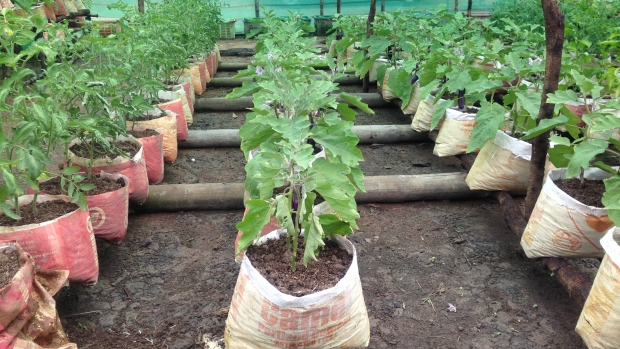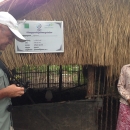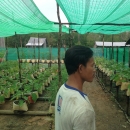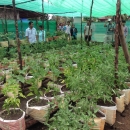Grants :: Small Grant Facilities :: Livelihood Diversification for Farmers through applying integrated adaptive farming system (LDF)
Livelihood Diversification for Farmers through applying integrated adaptive farming system (LDF)

Climate-smart integrated vegetable farming © RACHANA
Objectives
- To provide alternative livelihood for farmers through building and applying integrated farming system;
- To increase understanding of farmers on the impacts of climate change and disasters;
- To improve the quality of project implementation, management, and administration
Background
Tuol Torteung commune, Prey Nob district, Preah Sihanouk province, Cambodia is highly vulnerable to climate impacts on socio and ecological systems including high levels of population density and poverty (33.7%), sea level rise, storm surges and tropical storm, shoreline erosion, poor waste management, and lack of access to safe drinking water as well as lack of awareness on value of mangrove and poor infrastructure for effective waste management. In addition, the current adaptive capacity to future climate changes in the coastal areas is relatively low.
The target farmers are relied on agriculture and the most of them apply traditional wet season rice production. Among those, 35% grow white rice varieties and 65% grow red rice varieties[1]. The mains problems which are addressed by project are (i) lack of livelihood diversification and (ii) limited adaptive capacity among the target farmers. The project provides alternative livelihood options for the target farmers through building and applying integrated adaptive agriculture techniques to improve food security and income in their family as well as to reduce mangrove degradation activities in the target areas. It also aims to increase understanding of target farmers on climate change adaptation and disaster risk reduction. Moreover, the project is strongly aligned with many national laws, policies, and strategic action plan, especially Cambodia national strategy and action plan (C-NSAP) of mangrove for the future from 2014 to 2016. It is fitted to prioritized strategy number 2 (diversity local people’s livelihoods) and 4 (build coastal community resilience to climate change and natural disaster through practical experiences, local knowledge and ecosystems-based adaptation). In addition, the project works closely with the existing community to enhance and diversify their livelihood and incomes.
Target beneficiaries
In the project design, the project plans to provide direct benefits to 540 people including 270. However, during the project implementation 359 local people from 4 villages including 205 female were identified as the project beneficiaries.
Outputs
1. 60% of the target farmers applied integrated adaptive farming system in their family by 2017;
2. 60% of the target beneficiaries increased understanding on the impacts of climate change and disasters by 2017;
3. Project implementation, management, and administration are functioned well.
Accomplishments and challenges
Accomplishments:
- 52 farmers were trained in three topics identified; chicken raising, and vegetable growing activities;
- 16 farmers supported by the project to conduct demonstration on raising chickens and vegetable growing;
- 8 demonstrations on chicken farming installed;
- 9 demonstrations on vegetable growing installed in the village for farmers for learning.
- 6 times of community awareness raising activities on the impact of climate change and disaster with the involvement of 117 target farmers (female 84) including 3 village chiefs.
- The program manager conducted 1 time (two days and a half) to do field visit in all target villages, and coaching the project staff to improve the quality of works;
- ED and team leader visited one time at project site on chicken and vegetable demonstration.
Challenges:
- System of Rice intensification could not be applied during the late start-up of the project 3 months behind the start of new rainy season SRI;
- The innovation of new initiatives and apply the multi-cropping system adapt to climate changes required long term project and more inputs but the project was design short time.
- The source of the water for vegetable in the dry-season, the farmers brought the water from the distance and cost of money.
Contributions to cross-cutting themes
Gender equality:
During the project planning, implementation and monitoring stages, RACHANA prioritized social groups of women’s and girl's participation as they were recognized to be more affected by climate changes and disasters compared to men and boys. At quarter 4 of the project implementation, a project facilitator organized an internal study tour and it was found that the women's and men's participation was 47.9% and 52.1% respectively. In the village based reflection meeting, women's and men's participation was 64.9% and 35.1% respectively. In the workshop for the conclusion of project, women's and men's participation was 38.5% and 61.5% respectively.
On average women's participation in activities during the life cycle of the project was about 52.8%. Based on observations after the completion of the project, it was evident that women beneficiaries of the project were more inclined to work in the factories and the house work such as home gardening, poultry raising and child care was increasingly shared by the males in the household.
Climate change:
The project conducted awareness raising on the impacts of the climate changes and disasters. Results of the awareness raising the participants were interested to apply the approach to adapt to the climate changes that they have received the training coursed. Moreover the project provided the start-up inputs to the 26 farmers for poultries and vegetable activities to adapt the impacts of the climate changes. Through these application, a farmer has explored the new initiative to grow vegetable in the coconut shells that use less water and grow in the dry-season. The new idea of multi-cropping system was introduced to the farmers.
Conflict sensitivity:
The project organized the inception workshop to present the purposes, strategies and benefits of the target participants and collaboration of local authorities and relevant stakeholders. During the first quarter, the criterion selection of the beneficiaries was applied including (i) households who identified as ID Poor I or ID Poor II, (ii) willingness to provide contributions such as land, labor, and time, (iii) strong commitment in working with the project intervention, (iv) willingness to share resources, knowledge, skills, and experiences other farmers, and (v) readiness of farmers’ participation in conducting field researches/ demonstrations.
Lessons Learned
- When the project works with/for supporting the beneficiaries who cannot read and write local language, it should be clear that the community based approach and strategies such as developing the community expert of peer farmers;
- To promote and empower women engagement, it should provide what respond to their needs and interests such as the project provided them with access to the information and opportunities for the women to generate additional income.
- The farmers have applied the home vegetable and poultry raising adapt to the impacts of the climate changes; they have explored the initiative and creative to grow vegetable in the dry-season using less water. The multi-cropping and plants rotation system was the methods.
Project Facts
Country
Location
Tuol Torteung Commune, Prey Nub district, Preah Sihanouk province.
Topic
Duration
1st Jul 2016 to 30th Jun 2017
Co-financing Partner
RACHANA
Co-finance: 76,876,800 KHR / 19,219 USD
Implementing Partner
RACHANA
Dr. Um Sam Oeurn, Executive Director
Email: umsamoeurn@gmail.com/rachana.ngo@gmail.com
Phone: 012491 064
Contact person:
MR. CHENG DARA, Program Manager,
Email: daracheng@ymail.com/racheng.dara@gmail.com
Phone: 012-928 663/097-6 881 871/096-54 555 26


